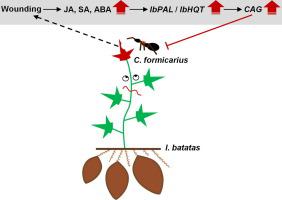Journal of Advanced Research ( IF 10.7 ) Pub Date : 2020-06-17 , DOI: 10.1016/j.jare.2020.06.011 Yinyin Liao 1, 2 , Lanting Zeng 1, 3 , Shunfa Rao 1, 4 , Dachuan Gu 1, 3 , Xu Liu 1, 3 , Yaru Wang 1, 2 , Hongbo Zhu 5 , Xingliang Hou 1, 2, 3 , Ziyin Yang 1, 2, 3

|
Sweetpotato weevil is among the most harmful pests in some major sweetpotato growing areas with warm climates. To enable the future establishment of safe weevil-resistance strategies, anti-weevil metabolites from sweetpotato should be investigated. In the present study, we pretreated sweetpotato leaves with exogenous chlorogenic acid and then exposed them to sweetpotato weevils to evaluate this compound’s anti-insect activity. We found that chlorogenic acid applied to sweetpotato conferred significant resistance against sweetpotato-weevil feeding. We also observed enhanced levels of chlorogenic acid in response to weevil attack in sweetpotato leaves. To clarify how sweetpotato weevils regulate the generation of chlorogenic acid, we examined key elements of plant-herbivore interaction: continuous wounding and phytohormones participating in chlorogenic acid formation. According to our results, sweetpotato weevil-derived continuous wounding induces increases in phytohormones, including jasmonic acid, salicylic acid, and abscisic acid. These phytohormones can upregulate expression levels of genes involved in chlorogenic acid formation, such as IbPAL, IbC4H and IbHQT, thereby leading to enhanced chlorogenic acid generation. This information should contribute to understanding of the occurrence and formation of natural anti-weevil metabolites in sweetpotato in response to insect attack and provides critical targets for the future breeding of anti-weevil sweetpotato cultivars.
中文翻译:

甘薯叶中绿原酸的诱导生物合成赋予了对甘薯象鼻虫攻击的抗性。
甘薯象鼻虫在气候温暖的一些主要甘薯种植区是最有害的害虫之一。为了将来能够建立安全的防象鼻虫策略,应该研究甘薯中的防象鼻虫代谢产物。在本研究中,我们用外源绿原酸预处理甘薯叶,然后将其暴露于甘薯象鼻虫中以评估该化合物的抗昆虫活性。我们发现将绿原酸应用于甘薯赋予了对甘薯象鼻虫喂养的显着抵抗力。我们还观察到响应甘薯叶中象鼻虫攻击而产生的绿原酸水平提高。为了阐明甘薯象鼻虫如何调节绿原酸的生成,我们研究了植物与草食动物相互作用的关键要素:持续的伤害和植物激素参与绿原酸的形成。根据我们的研究结果,甘薯象鼻虫引起的持续伤害会导致植物激素(包括茉莉酸,水杨酸和脱落酸)的含量增加。这些植物激素可以上调参与绿原酸形成的基因的表达水平,例如IbPAL,IbC4H和IbHQT,从而导致增强绿原酸的产生。这些信息应有助于人们了解甘薯中天然抗象甲虫代谢产物对昆虫的侵袭和形成,并为今后开发抗甲虫甘薯品种提供重要目标。



























 京公网安备 11010802027423号
京公网安备 11010802027423号